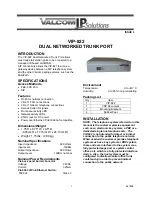
REGULATORY STATEMENTS
FCC Certification
The United States Federal Communication Commission (FCC)
and the Canadian Department of Communications have
established certain rules governing the use of electronic
equipment.
Part15, Class B
This device complies with Part 15 of FCC rules. Operation is
subject to the following two conditions:
1) This device may not cause harmful interface, and
2) This device must accept any interface received, including
interface that may cause undesired operation. This
equipment has been tested and found to comply with the
limits for a Class B digital device, pursuant to Part 15 of the
FCC Rules. These limits are designed to provide reasonable
protection against harmful interference in a residential
installation. This equipment generates, uses and can radiate
radio frequency energy, and if not installed and used in
accordance with the instructions, may cause harmful
interference to radio communications. However, there is no
guarantee that interference will not occur in a particular
installation. If this equipment does cause harmful
interference to radio
or television reception, which can
be determined by turning off and on, the user is encouraged
to try to correct the interference by one or more of the
following measures:
Reorient or relocate the receiving antenna.
Increase the distance between the equipment and receiver.
Connect the equipment into an outlet on a circuit different
from that to which the receiver is connected.
CAUTION:
1) To comply with FCC RF exposure compliance
requirements, a separation distance of at least 20 cm must
be maintained between the antenna of this device and all
persons.
2) This transmitter must not be co-located or operating in
conjunction with any other antenna or transmitter.



































